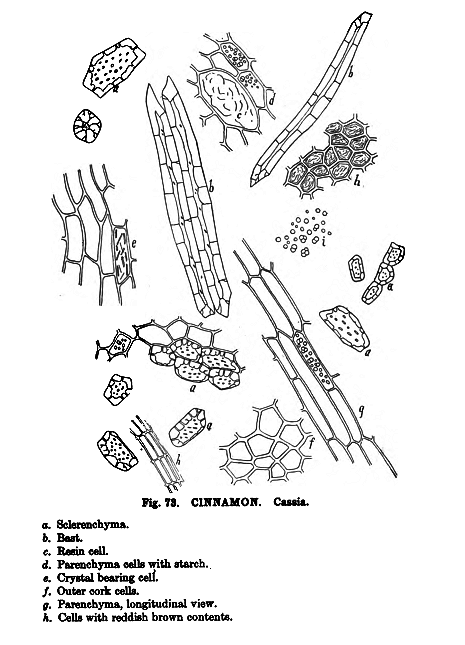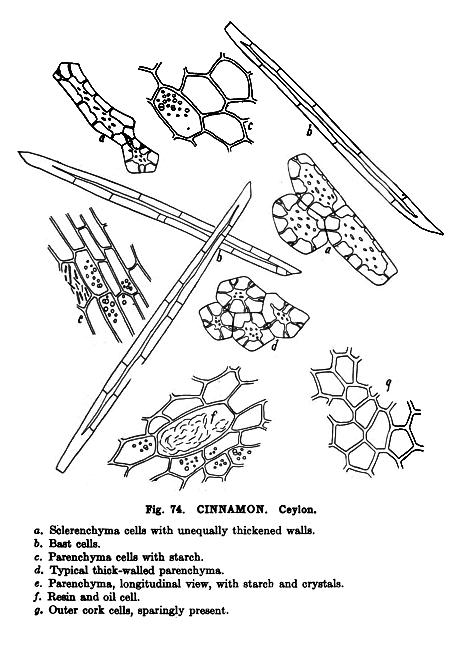Cinnamomum spp. (bark)
Cinnamon (powdered bark) (Cinnamomum aromaticum) Lauraceae. (Cassia Cinnamon)
General Characteristics Rather short, thick walled bast cells sclerenchyma with cell walls unequally thickened parenchyma cells with compound starch granules; cells with numerous small prismatic crystals; large resin bearing cells; cells of outer bark suberized and with reddish brown contents. Cassia bark contains relatively more starch than do the other varieties of cinnamon barks and relatively less bast tissue.
Color Cinnamon brown (reddish brown).
Scent Fragrant, aromatic, very characteristic.
Flavor Sweet, pungent, somewhat astringent.
Ash Content Ash about 6.5 per cent.
Reported Adulterants Cassia cinnamon in particular is likely to be adulterated with inferior cassia barks, clove bark, flour, inert vegetable substances. The quality of cassia cinnamon is proportionate to the number of bast cells present. The very inferior grades show few bast cells, which indicates that the outer older bark tissue predominates. Cassia cinnamons could readily be graded according to the bast cell count. The organoleptic tests, especially taste and odor, are also valuable guides to quality.
Source: Schneider, A. (1921) The Microanalysis of Powdered Vegetable Drugs, 2nd ed. [1]
Saigon Cinnamon (powdered bark) (Cinnamomum loureiroi), Lauraceae. (Vietnamese Cassia)
General Characteristics Histology much like that of Cassia; bast cells somewhat larger. Starch and sclerenchyma cells much as in Cinnamon aromaticum. Numerous small epidermal cells with thickened walls. Resin cells and crystals as in the other cinnamons.
Color Rather dark cinnamon brown (reddish brown).
Scent Fragrant, very aromatic.
Flavor Sweet, very pungent, astringent.
Ash Content Ash about 5 per cent.
Reported Adulterants Adulterations as for Cassia cinnamon; inferior cassia barks, clove bark, flour, inert vegetable substances. The very best grades [are] used by the Chinese in their medical practices. The Chinese quality test is based upon the thickness of the oil bearing layer of the bark.
Source: Schneider, A. (1921) The Microanalysis of Powdered Vegetable Drugs, 2nd ed. [2]
Ceylon Cinnamon (powdered bark) (Cinnamomum verum) B., Lauraceae. (Cinnamomum Zylanicum)
General Characteristics Histology much like that of Cassia Cinnamon; bast cells are more abundant and the cells of the outer cork wanting; starch less abundant. It is possible to distinguish this cinnamon from the other two by the larger sclerenchyma cells and absence of outer cork and epidermal tissues.
Color Rather light cinnamon brown (reddish brown).
Scent Delicately fragrant and aromatic.
Flavor Sweet, pungent, slightly astringent.
Ash Content Ash 4 per cent.
Reported Adulterants Adulterations as for Cassia cinnamon; inferior cassia barks, clove bark, flour, inert vegetable substances.
Source: Schneider, A. (1921) The Microanalysis of Powdered Vegetable Drugs, 2nd ed. [3]
Cite error: <ref> tags exist, but no <references/> tag was found


